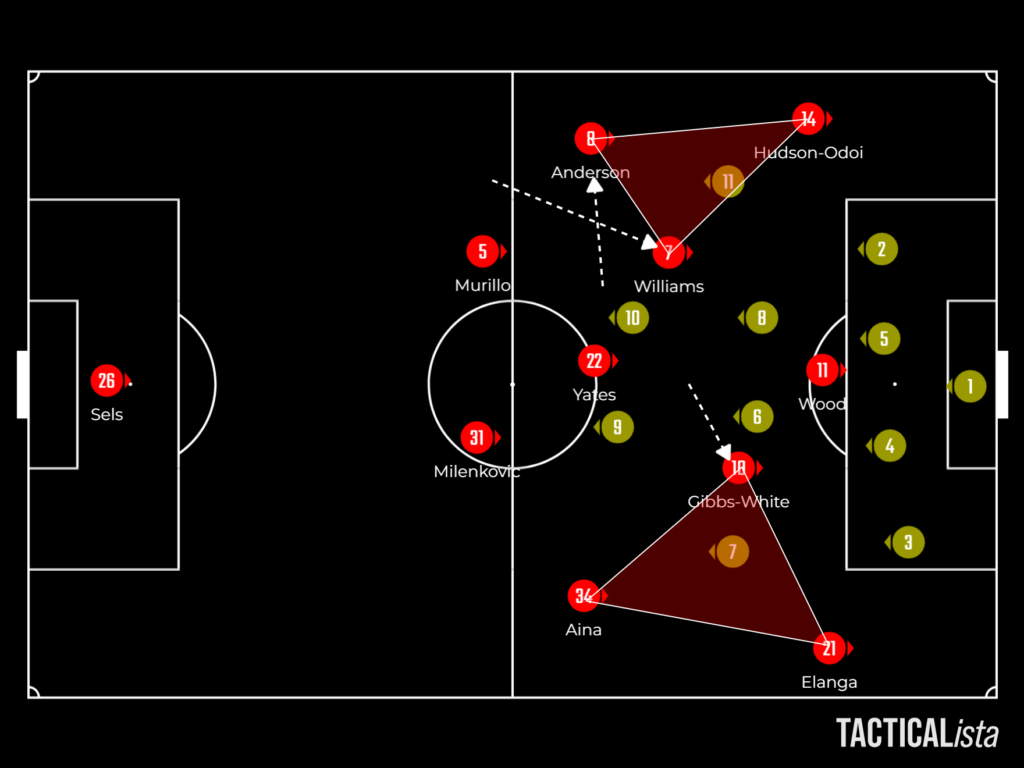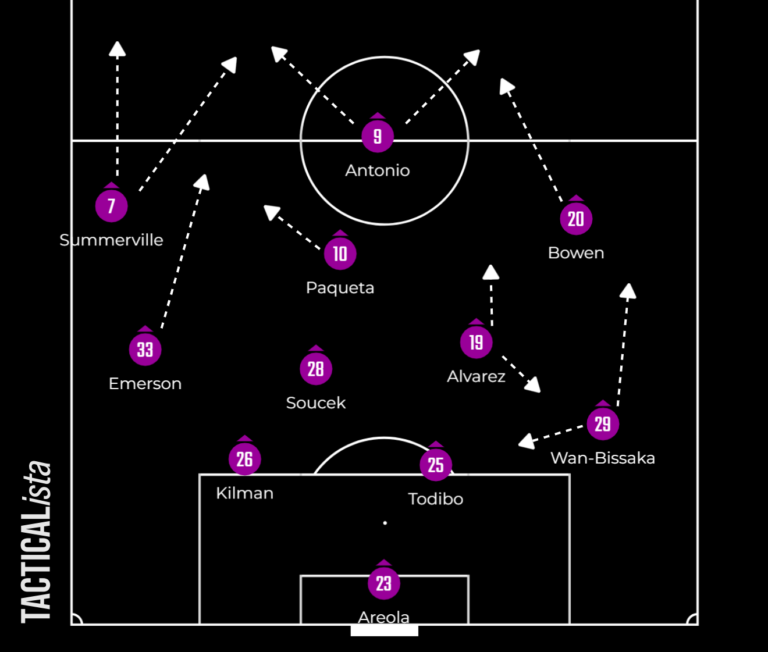Halfway through the Premier League season, Nottingham Forest are up to third place after narrowly avoiding relegation last season. It’s a fairytale story led by Nuno Espírito Santo, a manager who was written off after his disappointing spell at Tottenham. Let’s take a closer look at how he’s set up his team:
The Out-of-possession set-up
Nottingham Forest have the lowest average possession in the league, with just 39.5%, and engage in the fewest tackles in the attacking and middle thirds. They are a team comfortable sitting in a low block and defending their own third, where they register the second-most tackles in the Premier League, only behind Wolves.
The High Press
In certain situations, Nuno’s team opts to press goal kicks. However, they are not particularly aggressive in their press. Forest focus on closing off central areas and forcing the opposition onto one side. Once the opposition advances into midfield positions, often bypassing Chris Wood, Forest’s midfielders engage in the press. Their aim is either to win the ball high up the pitch or force the opposition into a long and uncontrolled ball, where Forest’s full-backs and Murillo at center-back have the space to recover.
The Mid Block
Most often, Forest sit in a passive mid-block with the goal of forcing the opposition wide without actively pressing. Their defense and midfield are heavily man-oriented, closely marking their opponents. They move slowly and deliberately, waiting to pounce when the opposition is forced into vulnerable positions.
Chris Wood tries to split the center-backs, forcing them to play wide to a full-back or a winger holding width. Callum Hudson-Odoi and Anthony Elanga position themselves centrally to prevent progression through the middle. When the ball moves wide, Forest see this as a trigger to press, with the entire team shifting toward the ball to suffocate the opposition.
The central midfielders—whether Anderson, Yates, Domínguez, or Danilo—are tenacious and eager to win the ball, often helping out in wide areas once the press is triggered. Morgan Gibbs-White has a free role out of possession, either leading the press in a 4-4-2 shape alongside Chris Wood or dropping deeper to assist the midfield when necessary.
Forest’s narrow shape can lead to struggles against build-ups with a three-man base, where wide center-backs carry the ball forward. Their man-marking approach also causes issues, particularly when the opposition striker drops deep. While Murillo is comfortable stepping out of the backline, Milenković prefers to hold his position, which can lead to overloads in certain areas.
The Low Block
Forest’s low block aims to close off Zone 14 (the central area just in front of the penalty box) and maintain a compact shape. The back four is very narrow, with the wingers dropping almost in line with the defense to cover wide areas and prevent crosses. The three midfielders focus on closing down spaces and intercepting passes, and even Chris Wood occasionally helps out.
This strategy leaves significant space out wide, which the central midfielders can’t always cover. However, deep crosses are often cleared effectively by Milenković, who ranks in the top five percent of center-backs for aerial duels won.
Transitions
Nottingham Forest are heavily focused on counterattacks. When they win the ball, wingers like Hudson-Odoi and Elanga utilize their speed to burst forward, often before a pass is even played. They exploit the space in wide areas, which many teams leave open due to their focus on central zones in possession.
Forest have several strong ball carriers, including Ola Aina and Hudson-Odoi, who post impressive numbers in progressive carries. Summer signing Elliott Anderson in midfield also contributes significantly to bringing the ball forward. However, the primary focus in transitions is Morgan Gibbs-White. The young Englishman has elevated his game this season and takes on a lot of responsibility in the team.
When Forest win the ball, it often goes first to Gibbs-White, who carries it up the pitch before playing it wide to one of the wingers. The wingers then either aim for goal themselves or deliver a cross back into the box. Gibbs-White’s ability to make the right decisions after advancing the ball is crucial. Their goals against Tottenham and Wolves (coincidentally, Nuno’s previous clubs) exemplify what the Portuguese manager expects from his team.
The In-possession set-up
Nottingham Forest primarily look for direct balls forward to get their pacey wingers in behind the defense. However, if the opposition prevents these transitions and gets players behind the ball, Nuno’s side has solutions.
The main focus is on creating wide overloads and bringing Hudson-Odoi and Elanga into play. Elliott Anderson, who often plays as a left central midfielder, drops into a typical left-back position, opening up space in midfield for Neco Williams to exploit. Forest are fortunate to have two versatile full-backs in Williams and Aina, who can both play as left-back or right-back and are comfortable on their weaker foot. Due to their technical ability and spatial awareness, they can invert into midfield or move up and down the line, utilizing their pace and power.
On the right-hand side, Gibbs-White helps create overloads with Aina and Elanga. The aim is to reach the byline and deliver balls into the box. A typical pattern involves a ball from deep into the half-space to release the winger.
Depending on the opposition, Ola Aina may take a more conservative role to help defend against transitions.








